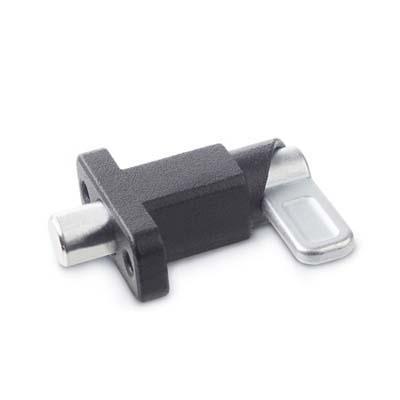
J.W. Winco Inc. offers series GN 722.2 Square Spring Latches with Flange for Surface Mounting. These spring latches are designed for use in applications where less precise positioning/locking is required. The dimensional tolerances are therefore chosen for cost-effective production, while insuring that functional safety is guaranteed when exposed to dirty or dusty environments. They provide high dynamic and static strength and can be loaded from any direction with approved safety (safety factor 4).
This type of spring latch is used when the indexing pin needs to be retracted. The indexing pin retracts by turning the latch up the cam slope by 180 degrees. A lock notch will hold the latch in both positions. The flange has two holes for mounting that can accommodate metric DIN 933/931 hex cap screws or DIN 912 socket cap screws. Equivalent inch size screws may potentially also be used for mounting the latch. The guide body is steel, precision cast, with either a zinc plated finish or black textured finish. The precision cast latch and the plunger pin are zinc plated, blue passivated steel. The spring latches are available in versions with the latch position either right-angled or parallel to the mounting holes, and are RoHS compliant.
Contact Details
Related Glossary Terms
- computer-aided manufacturing ( CAM)
computer-aided manufacturing ( CAM)
Use of computers to control machining and manufacturing processes.
- parallel
parallel
Strip or block of precision-ground stock used to elevate a workpiece, while keeping it parallel to the worktable, to prevent cutter/table contact.
- turning
turning
Workpiece is held in a chuck, mounted on a face plate or secured between centers and rotated while a cutting tool, normally a single-point tool, is fed into it along its periphery or across its end or face. Takes the form of straight turning (cutting along the periphery of the workpiece); taper turning (creating a taper); step turning (turning different-size diameters on the same work); chamfering (beveling an edge or shoulder); facing (cutting on an end); turning threads (usually external but can be internal); roughing (high-volume metal removal); and finishing (final light cuts). Performed on lathes, turning centers, chucking machines, automatic screw machines and similar machines.
